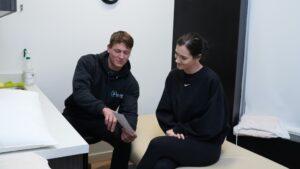Frozen shoulder, medically known as adhesive capsulitis, is a condition characterized by stiffness and pain in the shoulder joint. If you’ve ever dealt with frozen shoulder you know that it can significantly impede your movement and disrupt daily activities. Understanding its symptoms, causes, and treatment options is crucial for managing this condition.
What is Frozen Shoulder?
Frozen shoulder occurs when the connective tissue surrounding the shoulder joint becomes inflamed, thickened, and tight. This leads to a decrease in the joint’s range of motion, causing stiffness and shoulder pain. While the exact cause of frozen shoulder is not always clear, certain factors such as prolonged immobility, injury, diabetes, and hormonal imbalances may increase the risk of developing this condition.
Frozen Shoulder Symptoms
Recognizing the symptoms of frozen shoulder is essential for early diagnosis and treatment. The hallmark signs include:
- Pain: Persistent pain in the shoulder joint, which may worsen at night or with movement.
- Stiffness: Gradual loss of shoulder mobility, making it challenging to perform daily tasks like reaching overhead or behind the back.
- Limited Range of Motion: Difficulty lifting the arm or rotating it outward.
- Muscle Weakness: Weakening of the muscles surrounding the shoulder due to lack of use.
- Difficulty Sleeping: Discomfort may worsen at night, affecting sleep quality.
- Progressive Symptoms: Symptoms typically develop gradually over time and may worsen if left untreated.
 Frozen Shoulder Causes
Frozen Shoulder Causes
The exact cause of adhesive capsulitis is not fully understood, but several factors may contribute to its development:
- Immobilization: Prolonged periods of immobility, such as after surgery or injury, can lead to the formation of adhesions within the shoulder joint.
- Inflammation: Conditions such as diabetes or arthritis can cause inflammation in the shoulder joint, leading to the thickening of the capsule.
- Hormonal Imbalances: Certain hormonal changes, such as those seen in women during menopause, may increase the risk of developing frozen shoulder.
- Autoimmune Disorders: In some cases, the body’s immune system may attack the tissues surrounding the shoulder joint, leading to inflammation and stiffness.
Frozen Shoulder Treatment and How Synergy Rehab Can Help
Managing the pain and stiffness associated with frozen shoulder often requires a multifaceted approach. At Synergy Rehab, we offer a range of treatments aimed at improving shoulder mobility and reducing discomfort. Some of these modalities include:
- Physical Therapy: Tailored exercises and stretches can help improve shoulder movement and strengthen surrounding muscles.
- Manual Therapy: Hands-on techniques such as massage and joint mobilization can help alleviate stiffness and improve range of motion.
- Modalities: Therapeutic modalities such as heat, ice, and electrical stimulation may provide temporary pain relief.
- Shockwave Therapy: Shockwave therapy is a non-invasive treatment that uses acoustic waves to stimulate healing in the affected tissues. This therapy can help break down scar tissue and improve blood flow to the shoulder joint, promoting faster recovery from frozen shoulder.
Shockwave Therapy for Frozen Shoulder
Shockwave therapy has emerged as a promising treatment option for frozen shoulder. By delivering high-energy acoustic waves to the affected area, shockwave therapy stimulates cellular repair and regeneration, helping to break down scar tissue and improve tissue flexibility. This can result in significant pain relief and improved shoulder mobility for individuals suffering from frozen shoulder.
At Synergy Rehab, our experienced therapists utilize state-of-the-art shockwave therapy technology to target the root cause of frozen shoulder and promote faster healing.
Gentle Frozen Shoulder Exercise for At-Home Relief
In addition to professional therapy sessions, incorporating gentle exercises into your daily routine can help alleviate symptoms of frozen shoulder. These exercises focus on gradually increasing shoulder mobility and strengthening the surrounding muscles. A few recommended exercises include:
Pendulum swings: Stand with your unaffected arm resting on a table or chair for support. Lean forward slightly and let your affected arm hang freely. Gently swing your arm back and forth, side to side, and in circles to encourage movement in the shoulder joint.
Wall climbs: Stand facing a wall with your fingertips touching the wall at waist height. Slowly walk your fingers up the wall, raising your arm as high as you comfortably can. Hold for a few seconds, then slowly lower your arm back down. Repeat several times, gradually increasing the height each time.
Shoulder rolls: Stand or sit with your arms relaxed at your sides. Slowly roll your shoulders forward in a circular motion, then roll them backward. Repeat several times, focusing on smooth, controlled movements to loosen up the shoulder joint.
Gentle stretching: Stand tall with your feet shoulder-width apart. Reach your affected arm across your body and use your unaffected hand to gently press it further, feeling a stretch in the shoulder. Hold for 15-30 seconds, then release. Repeat on the other side. You can also gently stretch your affected arm overhead, holding onto a stable object for support if needed.
It’s important to perform these exercises slowly and cautiously, stopping if you experience any pain of discomfort. Always consult with your physical therapist for personalized health information to ensure any new exercise regimen is safe and appropriate for your shoulder injury.
 When Frozen Shoulder Surgery May Be Needed
When Frozen Shoulder Surgery May Be Needed
While most cases of frozen shoulder can be effectively managed with conservative treatments, surgical treatment may be considered in severe or persistent cases that do not respond to other interventions. Surgical options for frozen shoulder may include:
- Manipulation Under Anesthesia (MUA): A procedure where the surgeon manipulates the shoulder joint to break up scar tissue and improve mobility.
- Arthroscopic Capsular Release: A minimally invasive surgery where the surgeon releases tight or thickened tissues surrounding the shoulder joint, allowing for improved range of motion.
Surgery is typically reserved for cases where conservative treatments have failed to provide relief, and the individual’s quality of life is significantly impacted by the frozen shoulder.
Dealing With Frozen Shoulder Pain? We Can Help
Understanding the symptoms, causes, and treatment options for frozen shoulder is essential for effectively managing this condition. With comprehensive care and innovative treatments, Synergy Rehab is dedicated to helping you overcome the challenges of shoulder stiffness, shoulder injuries, and frozen shoulder to regain function and mobility in your shoulder joint. Schedule a same day appointment at Synergy Rehab to explore the various treatment options available to you, today.








